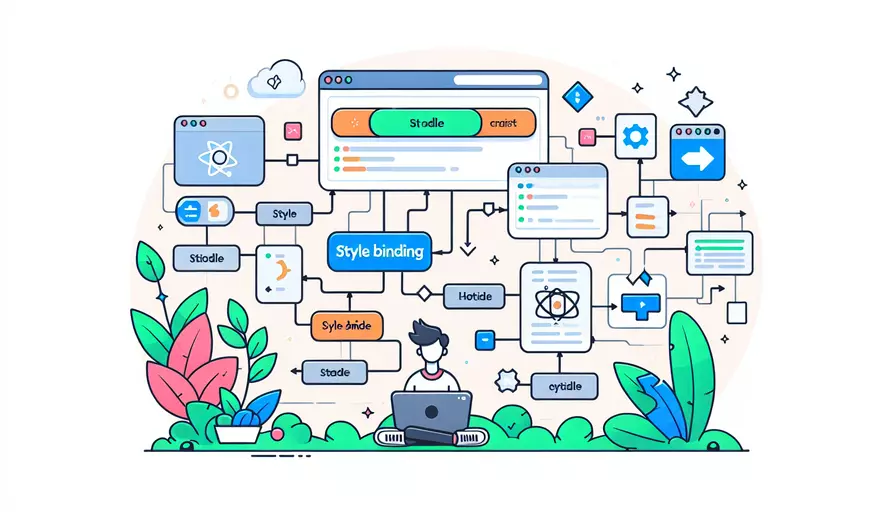
在Vue中绑定样式有几种常见的方法:1、使用v-bind:class绑定类名,2、使用v-bind:style绑定内联样式,3、使用计算属性动态生成样式对象。以下将详细描述这些方法,并提供相应的代码示例和使用场景。
一、使用v-bind:class绑定类名
使用v-bind:class指令可以动态绑定一个或多个类名,这在需要根据条件动态添加或移除类时非常有用。
-
对象语法
<template><div :class="{ active: isActive, 'text-danger': hasError }"></div>
</template>
<script>
export default {
data() {
return {
isActive: true,
hasError: false
};
}
};
</script>
在上述代码中,
active类会根据isActive的值进行添加或移除,text-danger类会根据hasError的值进行添加或移除。 -
数组语法
<template><div :class="[isActive ? 'active' : '', errorClass]"></div>
</template>
<script>
export default {
data() {
return {
isActive: true,
errorClass: 'text-danger'
};
}
};
</script>
在上述代码中,
active类会根据isActive的值进行添加或移除,errorClass的值会作为类名添加。
二、使用v-bind:style绑定内联样式
使用v-bind:style指令可以动态绑定内联样式,这在需要根据条件动态改变样式属性时非常有用。
-
对象语法
<template><div :style="{ color: activeColor, fontSize: fontSize + 'px' }"></div>
</template>
<script>
export default {
data() {
return {
activeColor: 'red',
fontSize: 14
};
}
};
</script>
在上述代码中,
color属性会根据activeColor的值进行设置,fontSize属性会根据fontSize的值加上px单位进行设置。 -
数组语法
<template><div :style="[baseStyles, overridingStyles]"></div>
</template>
<script>
export default {
data() {
return {
baseStyles: {
color: 'red',
fontSize: '14px'
},
overridingStyles: {
fontSize: '16px'
}
};
}
};
</script>
在上述代码中,
baseStyles和overridingStyles会被合并,overridingStyles中的fontSize会覆盖baseStyles中的fontSize。
三、使用计算属性动态生成样式对象
使用计算属性可以动态生成样式对象,便于管理复杂的样式逻辑。
-
绑定计算属性
<template><div :class="classObject" :style="styleObject"></div>
</template>
<script>
export default {
data() {
return {
isActive: true,
errorClass: 'text-danger',
activeColor: 'red',
fontSize: 14
};
},
computed: {
classObject() {
return {
active: this.isActive,
'text-danger': !this.isActive
};
},
styleObject() {
return {
color: this.activeColor,
fontSize: this.fontSize + 'px'
};
}
}
};
</script>
在上述代码中,
classObject和styleObject是计算属性,根据组件的状态动态生成类名和样式。
四、组合使用v-bind:class和v-bind:style
在实际项目中,经常需要同时使用v-bind:class和v-bind:style来实现复杂的样式绑定。
-
结合使用
<template><div :class="classObject" :style="styleObject"></div>
</template>
<script>
export default {
data() {
return {
isActive: true,
errorClass: 'text-danger',
activeColor: 'blue',
fontSize: 16
};
},
computed: {
classObject() {
return {
active: this.isActive,
'text-danger': !this.isActive
};
},
styleObject() {
return {
color: this.activeColor,
fontSize: this.fontSize + 'px'
};
}
}
};
</script>
在上述代码中,
classObject和styleObject分别用于绑定类名和样式,实现更加灵活的样式控制。
五、实例说明
在一个实际的项目中,假设我们有一个按钮组件,需要根据用户的操作动态改变按钮的样式和类名。以下是一个示例:
<template>
<button :class="buttonClass" :style="buttonStyle" @click="toggleState">
{{ buttonText }}
</button>
</template>
<script>
export default {
data() {
return {
isActive: false,
activeColor: 'green',
inactiveColor: 'gray',
fontSize: 18
};
},
computed: {
buttonClass() {
return {
active: this.isActive,
inactive: !this.isActive
};
},
buttonStyle() {
return {
color: this.isActive ? this.activeColor : this.inactiveColor,
fontSize: this.fontSize + 'px'
};
},
buttonText() {
return this.isActive ? 'Active' : 'Inactive';
}
},
methods: {
toggleState() {
this.isActive = !this.isActive;
}
}
};
</script>
<style scoped>
.active {
background-color: lightgreen;
}
.inactive {
background-color: lightgray;
}
</style>
在上述代码中,按钮的样式和类名会根据isActive的状态动态改变,用户点击按钮时会触发toggleState方法,切换按钮的状态。
总结一下,在Vue中绑定样式的主要方法包括使用v-bind:class绑定类名、使用v-bind:style绑定内联样式、使用计算属性动态生成样式对象以及组合使用这两种方法。通过这些方法,可以实现更加灵活和动态的样式控制,使得组件的样式与数据状态紧密结合。建议在实际项目中根据具体需求选择合适的方法,同时注意代码的可读性和维护性。
相关问答FAQs:
1. 如何在Vue中动态绑定内联样式?
在Vue中,可以使用v-bind指令来动态地绑定内联样式。通过在HTML标签上使用v-bind来绑定一个JavaScript表达式,可以将其作为样式的值。例如,可以通过绑定一个data中的属性来动态改变样式。具体步骤如下:
- 在Vue实例的data选项中定义一个属性,用于存储样式的值。
- 在HTML标签上使用v-bind指令绑定该属性,作为样式的值。
以下是一个简单的示例:
<template>
<div :style="{ backgroundColor: color, fontSize: fontSize + 'px' }">
Hello, Vue!
</div>
</template>
<script>
export default {
data() {
return {
color: 'red',
fontSize: 16,
};
},
};
</script>
在上述示例中,color和fontSize属性被绑定到div标签的内联样式中。当这些属性的值发生变化时,样式也会相应地更新。
2. 如何在Vue中绑定类名?
除了绑定内联样式,Vue还提供了绑定类名的功能。通过使用v-bind指令,可以将一个表达式作为类名的值,从而动态地改变元素的类名。具体步骤如下:
- 在Vue实例的data选项中定义一个属性,用于存储类名的值。
- 在HTML标签上使用v-bind指令绑定该属性,作为类名的值。
以下是一个简单的示例:
<template>
<div :class="{ active: isActive, 'text-danger': isError }">
Hello, Vue!
</div>
</template>
<script>
export default {
data() {
return {
isActive: true,
isError: false,
};
},
};
</script>
在上述示例中,isActive和isError属性被绑定到div标签的类名中。当这些属性的值为true时,对应的类名将被添加到元素上。
3. 如何在Vue中使用样式对象来绑定样式?
除了绑定单个样式属性,Vue还支持使用样式对象来绑定多个样式属性。通过将一个对象作为样式的值,可以动态地改变多个样式属性的值。具体步骤如下:
- 在Vue实例的data选项中定义一个样式对象,用于存储样式属性和值的键值对。
- 在HTML标签上使用v-bind指令绑定该样式对象。
以下是一个简单的示例:
<template>
<div :style="styleObject">
Hello, Vue!
</div>
</template>
<script>
export default {
data() {
return {
styleObject: {
backgroundColor: 'blue',
fontSize: '20px',
color: 'white',
},
};
},
};
</script>
在上述示例中,styleObject对象被绑定到div标签的样式中。当styleObject中的属性值发生变化时,对应的样式属性也会相应地更新。
文章标题:vue中如何绑定样式,发布者:worktile,转载请注明出处:https://worktile.com/kb/p/3637143

 微信扫一扫
微信扫一扫  支付宝扫一扫
支付宝扫一扫 